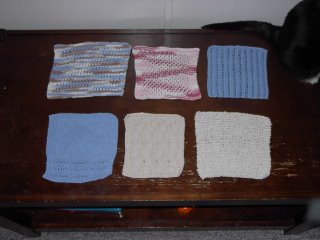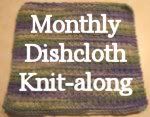Just a quickie today.
There is more frogging than knitting going on here today so I don't have a lot ot show you.
Here are my contributions to my project so far.

I love making up dishcloth patterns just using a good stitch dictionary. Just find a stitch pattern you like, read the number of stitches required add up enough stitch sequences to make a full sized dishcloth and don't forget to include enough for a garter stitch border.
Cast on, knit a few rows (usually four) then move into your stitch pattern.
For instance; let's say your stitch pattern uses a multiple of 4 plus 1.
Now, this means your pattern must be divisible by four with 1 extra stitch leftover. So you cast on 41 sts (40/4=10 repeats plus 1 for the extra stitch) for the stitch pattern and another 6 for your border, that will give you a total of 47 sts.
Knit four rows for a bottom border and always start and end your row with a minimum of 3 knit stitches. Your pattern look like; K3, insert stitch pattern here, K3.
Most people simplify things by adding to the first/last K sts to include to stitch pattern.
Huh? You say? If you're chosen stitch pattern starts out, K1, *K1, YO, K2tog, P1,* for that row you would simply write K4, *K1, YO, K2tog, P1* to last three, K3.
If it ends *K1, YO, K2tog, P1*, K1, then you would write; *K1, YO, K2tog, P1*, to last four stitches, K4.
Any questions? No, now go get your stitch dictionary or check out About.com's stitch library.
I'll try to answer any questions if you have them, but I just heard thunder and where there's thunder, there's lightning so I gotta go before I lose this post.
Here are my contributions to my project so far.

I love making up dishcloth patterns just using a good stitch dictionary. Just find a stitch pattern you like, read the number of stitches required add up enough stitch sequences to make a full sized dishcloth and don't forget to include enough for a garter stitch border.
Cast on, knit a few rows (usually four) then move into your stitch pattern.
For instance; let's say your stitch pattern uses a multiple of 4 plus 1.
Now, this means your pattern must be divisible by four with 1 extra stitch leftover. So you cast on 41 sts (40/4=10 repeats plus 1 for the extra stitch) for the stitch pattern and another 6 for your border, that will give you a total of 47 sts.
Knit four rows for a bottom border and always start and end your row with a minimum of 3 knit stitches. Your pattern look like; K3, insert stitch pattern here, K3.
Most people simplify things by adding to the first/last K sts to include to stitch pattern.
Huh? You say? If you're chosen stitch pattern starts out, K1, *K1, YO, K2tog, P1,* for that row you would simply write K4, *K1, YO, K2tog, P1* to last three, K3.
If it ends *K1, YO, K2tog, P1*, K1, then you would write; *K1, YO, K2tog, P1*, to last four stitches, K4.
Any questions? No, now go get your stitch dictionary or check out About.com's stitch library.
I'll try to answer any questions if you have them, but I just heard thunder and where there's thunder, there's lightning so I gotta go before I lose this post.






















3 Comments:
:-)
keep on knitting! Good work. Samplers are great, because you can try out new things w/o the pressure of committing to a stitch for a whole big project.
By Heather, at 2:44 PM, August 03, 2006
Heather, at 2:44 PM, August 03, 2006
Nice dishclothes! I just started knitting them and I'm hooked. I was going to start knitting up patterns from my stich dictionary - and can't find it! Argh!
By Jeanne, at 3:18 PM, August 03, 2006
Jeanne, at 3:18 PM, August 03, 2006
Those look great! I've got one about half done, but it's the only yarn I could find in warm tones. I'll see if I can make it over to Wal-Mart in time to pick up some.
By Charity, at 4:22 PM, August 03, 2006
Charity, at 4:22 PM, August 03, 2006
Post a Comment
<< Home